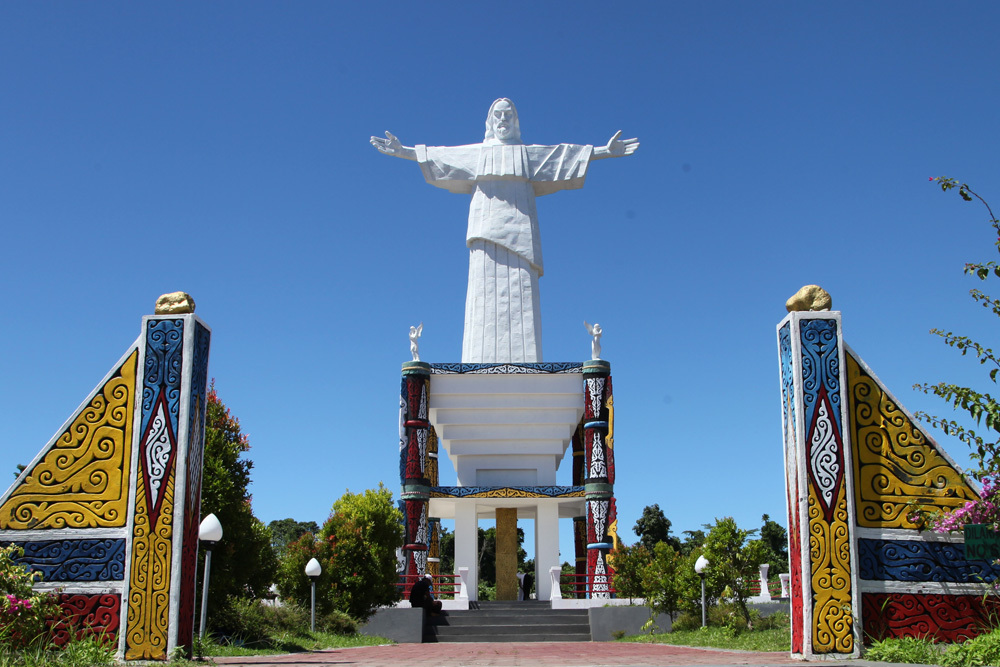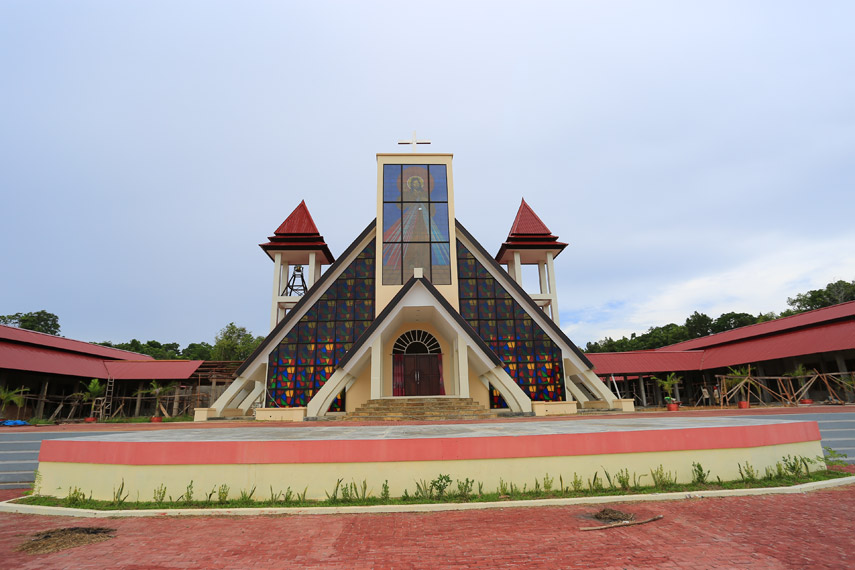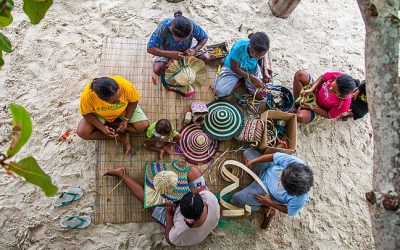Home / Batik Regions – Eastern Indonesia – West Papua / Mansinam Island
Cultural Destination
Embrace the spirit of the place!
Mansinam Island
Christ Monument at Mansinam Island (photo: @KSM tour)
Catholic Church at Mansinam Island, West Papua (photo: @Indonesia Kaya)
Mansinam Historical Island
This island is considered a holy place in Papua Island. It has been the witness of the two German catholic missionaries, Ottouw and Geissler who introduced the Christianity and modern civilisation to Papuan communities on the 5th February 1855. This island also stores the artefacts and memories of the first Christian Catholic community which was formed in Papua island. The old well, which was built by Ottouw and Geissler, has remained intact and still functioned to provide water supplies for the locals. Every 5th February, the Papuan Christian community gathers in this island to commemorate this historical day: the day when the bible was firstly introduced to the local inhabitants of the region. Do you want to experience an insightful spiritual journey? Come and feel the spirit of this place!
Cultural Tourism Destination
Mansinam Historical Island
Tourist Attractions in West Papua
Raja Ampat National Geopark
Situated in the World’s Triangle Coral Reefs, this region is the king of all
Love Lagoon in Misool
This love lagoon is formed by the natural phenomenon of a mountain lake and
Arborek Village
Come and enjoy some of your time with Arborek people. Try their food and discover
West Papua
Batik Motifs
Raja Ampat
Raja Ampat motif represents the marine life at Raja Ampat archipelago in
Honai
The Honai is inspired by the traditional house of the Papuan community living in
Burung Cendrawasih
The Cendrawasih bird is believed as sacred Paradise bird that connects the earth with
Prada Papua
The word “Prada” in the Javanese-Indonesian dialect means a batik textile that
Discover
Indonesian
Batik
Motifs
Gigi Haruan Lidi
The Gigi Haruan Lidi motif is taken from the name of the cork fish and is a symbol of
Bultiya
The word ‘Bultiya’ is an acronym of the three major tribes in North Kalimantan, namely
Jumputan Bintang
The word Jumputan means the tie-dye technique, while the word “Bintang” refers to
Tampuk Manggis Sasirangan
The motif illustrates the philosophy of the mangosteen fruit, which is
Biji Kopi
The coffee seeds motif illustrates the pride of local coffee specialities in
Wirasat
Wirasat or divine inspiration is a gift from God. This inspiration is symbolized by
Lok Baintan Floating Market
As you can imagine, the most authentic thing is that you can buy things and even
Jupri Kembang Teh
Kembang Teh illustrates the tendrils of tea plants that grow in the highlands of
Dayak Taghol
Dayak Taghol has a distinctive style of four curved lines and small dots. This motif represents
Srimanganti
The name of the Srimanganti motif is derived from Palace’s hallway that connects to
Lontara
The Lontara script itself is a typical ancient script of Bugis and Makassar communities. History records that
Teguh Bersatu
This batik motif shows the strength of the people of Kupang. It also represents a sense of
Tikar Natuna
The Tikar Natuna motif is adapted from the traditional making of pandanus mats in
Daun Lada Hitam
The black pepper motif represents the main commodity of Bangka Belitung
Gonggong Siput
Gonggong (Strombus Turturella) is one type of sea snail found around
Bomba Mawar
This motif means sacred love for family, kingdom, and God; It also illustrates
Kuda Kupang
Horses symbolize wealth. It contains noble values of virtuous characters that bring
Bale Lumbu
This motif signifies the welfare of the ancient Sasak society. Bale also symbolizes the
Kawung
The Kawung motif was created by Sultan Agung Hanyokrokusumo (1593 – 1645) as a symbolic gift for
Pinawetengan
The Pinawetengan Batik pattern was taken from a prehistoric inscription in
Dayak Kamang
Kamang motif is generally found in the Dayak tribe shield because it is believed to
Rangkiang
The word “Rangkiang” refers to the rice granary in the Minangkabau language. It symbolizes
Kaharingan
The Kaharingan or ‘tree of life’ based on the Dayak tribes’ belief system. This tree symbolizes
Daun Sirih
This motif illustrates betel leaves that are used by Lombok communities as traditional
Gorga Simeol-Meol
The Gorga Simeol-meol is a pattern of plant tendrils. it is regarded as a symbol of longevity and
Ukir Sentani
The Ukir motif is a batik motif that is inspired by various traditional Sentani wood carvings
Tangerang Herang
Tangerang Herang motif is a symbol of Tangerang city. The Tangerang Herang batik motif consists of
Sekar Jati
Sekar means flower and Jati refers to teak trees that symbolizes a strong mental character that
Sandeq
Sandeq Boat is a symbol of the maritime importance of the West Sulawesi region. The greatness of
Kasih Tak Sampai
‘Kasih Tak Sampai’ is an idiom in the Indonesian language which refers to
Singayaksa
The Singayaksa motif comes from the name of a place where Sultan Hasanuddin used to
Kain Cual
Cual textile tradition has existed since the 17th century. The word “Cual” refers to
Lipaq Sabe
Lipaq Saqbe contains a simple geometric classical motif with various flower decorations. This textile is
Gumin Tambun
Based on Hindu mythology, this motif symbolizes lucks, abundant wealth, and
Bekantan Pakis
This motif represents Pakis Haji (Polystichum setiferum), an endemic plant in
Karawo Pinang
Pinang refers to the Palm areca tree. This motif is considered as the original
Honai
The Honai is inspired by the traditional house of the Papuan community living in
Awan Berarak
Awan Berarak is a combination of Dayak motifs and Malay patterns. The word ‘Awan Berarak’ means the
Rumah Mamuju
the Batik motif illustrates the house of Mamuju King with the stairs, located on the left of the wooden stage house
Sero Tangga
The Sero Tangga illustrates an endearing feeling and sacrifices of a person to fulfil
Insang Ikan
Insang refers to the gills of the fish. This is a typical pattern of Malay ethnic who inhabits
Manguni Minahasa
Manguni is identified as the symbol of the Minahasa people. Manguni is known as a
Bintik Tujuh
The Bintik Tujuh (Seven Dots) motif has 7 white spots and green color gradation as
Parang Seling
Parang Seling or “alternating daggers” is a royal batik motif. It is a feminine variant of
Desa Na Tolu
The Desa Na Tolu characteristic pattern symbolizes the Batak philosophy of existence and
Prada Papua
The word “Prada” in the Javanese-Indonesian dialect means a batik textile that
Merak Ngeram
The hatching peacock motif has a very deep meaning which refers to the sacrifice and
Buketan Bali
The Balinese bouquet (Buketan Bali) is a floral arrangement and the name is
Ake Patra
Ake is related to the divinity and the composition of the universe. It is a symbol of
Gajah Way Kambas
The motif illustrates the Lampung’s natural reserve, the Way Kambas. it also symbolizes
Sido Mulyo
Sidomulyo is one of the classical motifs, which is specifically used for the bride’s costume in
Tongkonan
Toraja’s traditional house is called Tongkonan. Tongkonan is a place for
Malinau Cultural Festival
You will witness a unique competition that might not be found other than in
Leuit Sijimat
This motif reflects the daily activities of the Baduy tribe in Banten. The main ornaments of batik motif consist of:
Pohon Hayat (Tree of Life)
The Batik motifs in Lampung are dominated by the acculturation of Buddhist and
Cengkeh
The clove flower motif is the main commodity of the Tolitoli Regency. This motif represents
Angsa Duo
According to legend, the Angso duo batik motif is a pair of swans that are believed to have led Princess
Wakatobi
It symbolizes the coastal beauty of the Wakatobi island and the symbol of Patra symbolizes
Parang Rusak
Another meaning behind this motif is an unconquerable spirit, symbolized by
Tanah Liek
The word “Tanah Liek” refers to clay in Minang language. It is also known as
Pattimura
Pattimura is the name of an Indonesian hero who fought against colonialism in
Besurek Rembulan
This batik illustrates praise for God who created the wonderful universe
Hiu Taliyasan
Indonesia is also home to the world’s largest fish, the whale shark (Rhincodon typus). Hiu Taliyasan refers to
Tenun Bima
The motifs are adopted from Bima woven textile. This pattern has received a great
Daun Simpor
This motif is inspired by the Simpor plant (Dillenia Suffruticosa) which is a typical
Gentala Arasy
Built as high as 80 meters, the tower also highlights the historical side of
Tifa Totobuang
The batik motifs illustrate Maluku’s traditional music instrument called
Pala Salawaku
This motif illustrates the unique weapons of the Maluku region, namely
Gamolan
This motif illustrates Gamolan, a bamboo musical instrument of Lampung that is
Pati-Pati Pinehiku
It symbolizes the hierarchy in society and the social status of the Mekongga
Raja Ampat
Raja Ampat motif represents the marine life at Raja Ampat archipelago in
Gurdo Solo
Gurdo or garuda bird is the mount of the Indian god Vishnu. As the Sun Bird,
Sekomandi
Its philosophical meaning is the eternal union which refers to a saying “until death do us part”
Enggang Dayak
Local people beliefs that hornbills are an incarnation of the Commander of the Birds. It has supernatural







